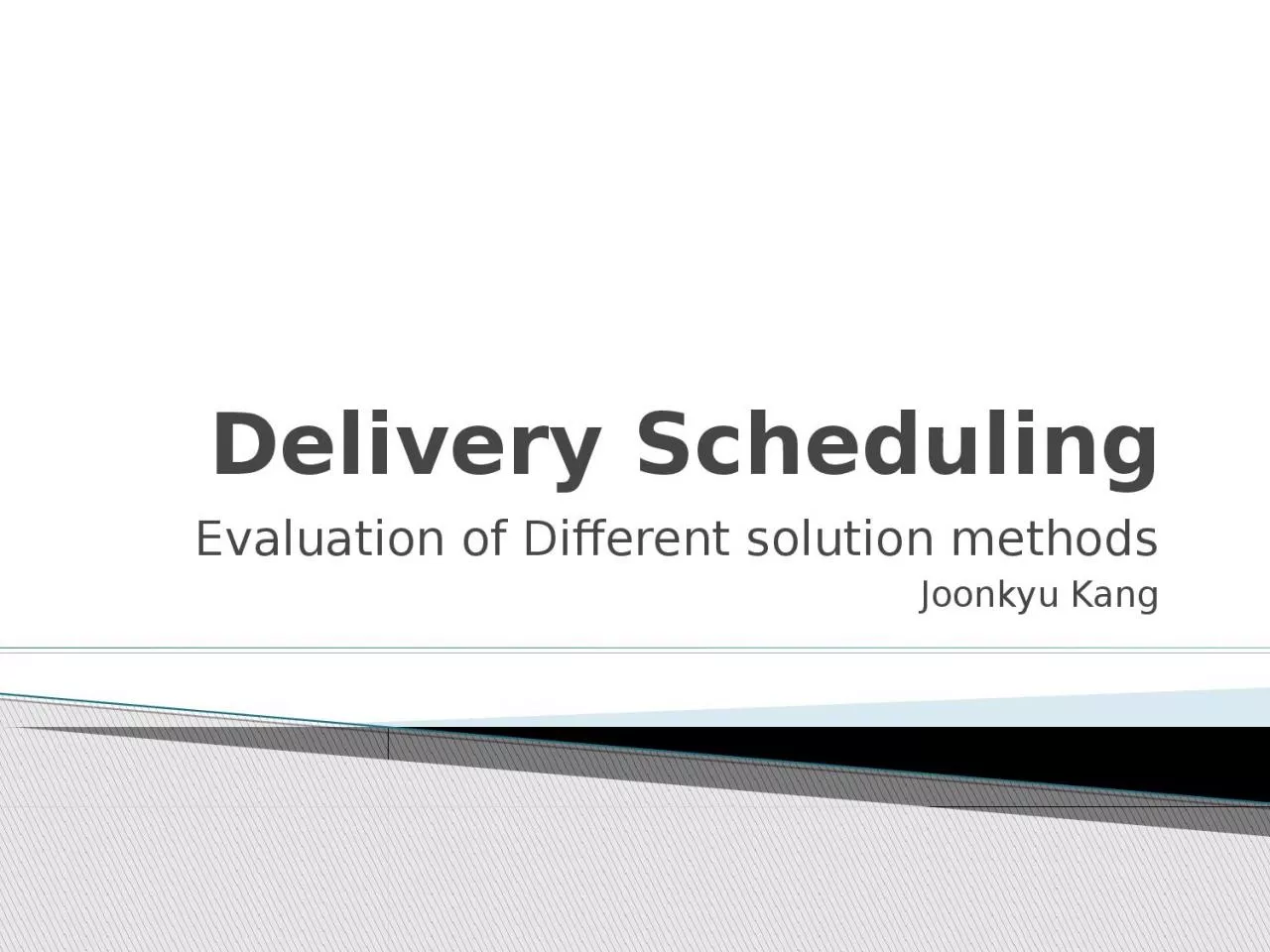

Joonkyu Kang Based on typical Fedex delivery situation Machines delivery trucks Jobs packages to be delivered Processing time traveling time to the destination Deadline different for each type of package ID: 1029023
Download Presentation The PPT/PDF document "Delivery Scheduling Evaluation of Differ..." is the property of its rightful owner. Permission is granted to download and print the materials on this web site for personal, non-commercial use only, and to display it on your personal computer provided you do not modify the materials and that you retain all copyright notices contained in the materials. By downloading content from our website, you accept the terms of this agreement.
1. Delivery SchedulingEvaluation of Different solution methodsJoonkyu Kang
2. Based on typical Fedex delivery situationMachines: delivery trucksJobs: packages to be deliveredProcessing time: traveling time to the destinationDeadline: different for each type of packageConstrained to Manhattan, New York area onlyObjective: two possible objectivesMinimizing tardiness of deliveryMaximizing the number of deliveryQuite similar, but can be differentWill concentrate on minimizing tardinessBuilding a Scheduling Problem
3. Simplifying Manhattan area into a graph Within the same zip code area, the traveling time is less than five minutesDefine vertices as different zip codes, and edges as distance between center of each areaCreate edges only between adjacent areasSince complete graph would take much more computational timePackages of the same type and delivery trucks have identical characteristicsNo further resource constraintsIgnore distance required to come back to the centerSimplifying Assumptions
4. MapStart at Fedex Ship Center at 25 W, 45th st, New York, NY, 10036Use Google Map to calculate cost of edgesPackagesBased on the revenues obtained, calculate the approximate percentage of each packageCost of each package delivery is 1Set deadlines based on package typesIn this simulation, we will use 200 packages.TrucksNormally, the number of trucks are very small compared to the number of packagesTherefore here we use 10 trucks here.Creating Data
5. If we have sufficient number of delivery trucks, we can assign one for each packageTotal delivery time: 415.88(Since every zipcode is in delivery locations)Total lateness: 16.20Also, the largest lateness of all packages is 4.310, but it is not as good as above(with delivery time 14.31) Poor Lower Bounds
6. First notice this is a NP ProblemTo minimize lateness, the simplest approach would be using EDD ruleThe algorithm is:First align jobs according to the due dateAssign each job to each empty truckA greedy algorithm in terms of latenessAlgorithm #1: EDD Rule
7. …for i=1:Count [TotalTime Assignment] = min(TruckTime); CurrentLoc = TruckLocation(Assignment); MatLoc = find(Distance==CurrentLoc); Destination = Packages(i,4); DestLoc = find (Distance==Destination); CurrentTime = Distance(MatLoc(1), DestLoc(1)); TruckTime(Assignment)=TruckTime(Assignment)+CurrentTime; TruckLocation(Assignment)=Destination; JobAssign(Assignment,i)=i; Tmp = TruckTime(Assignment)-Packages(i,3); disp(Tmp); Lateness = Lateness + max(TruckTime(Assignment)-Packages(i,3),0);End…Simulation Code
8. Processing time of 1,638.2, Lateness of 12,322ProblemsExtremely high lateness compared to the lower bound we obtainedNeed to find a better lower boundNeed to compare to other methodsNo consideration of processing timeMany factors affect the performance of the algorithm in this problem; not simply deadline.Result and Problems
9. Here we process each package in orderHowever, at each turn the truck closest to the next package is assigned for deliveryRepeat until all packages are assignedAlgorithm #2: Greedy Algorithm
10. Destination = Packages(i,4); DestLoc = find (Distance==Destination); MinTruck = 0; MinTruckNo = 0; MinDistance = 99999; for j=1:MNo TempTruck = TruckLocation(j); TempTruckLoc = find (Distance==TempTruck); TempDist = Distance(DestLoc(1), TempTruckLoc(1)); if TempDist < MinDistance MinTruckNo = j; MinTruck = TempTruckLoc(1); MinDistance = TempDist; end end CurrentTime = Distance(MinTruck, DestLoc(1)); TruckTime(MinTruckNo)=TruckTime(MinTruckNo)+CurrentTime; TruckLocation(MinTruckNo)=Destination; JobAssign(MinTruckNo,i)=i; Lateness = Lateness + max(TruckTime(MinTruckNo)-Packages(i,3),0);Simulation Code
11. Processing time of 480.68 total, with lateness of 2770.6ProblemsMuch better result, but with some latenessThe closest truck to the next delivery location is not always the best choice for tardinessNeed to incorporate choice of packagesAlso, the completion time of trucks vary; therefore extra lateness occursResult and Problems
12. By using a greedy algorithm, we could obtain somewhat satisfying schedule in terms of processing timeHowever, we are not completely sure if the large lateness is because of the number of trucks or the problem of algorithmsWe can expect to obtain the tardiness closer to the lower bound by making the completion time of each truck even Conclusion
13. Critical Path Method: Applying Graph TheoryDefine an appropriate sink node and apply the following algorithm:For each truck, find a critical path to the sinkDelete the path previously usedProblems: is independent of the characteristics of packages. Data size gets enormous.Check sensitivity of algorithms by changing factorsIn order to have completion time even, mix different algorithmsFurther Development
14. Fedex Website(www.fedex.com/us )Google Map(maps.google.com)Class Notes on NP-CompletenessReferences